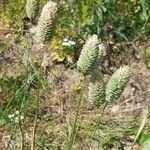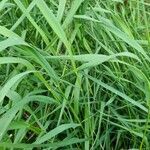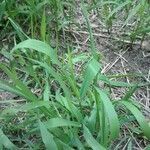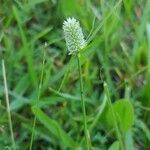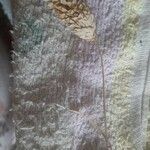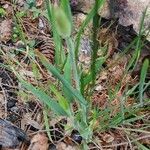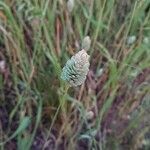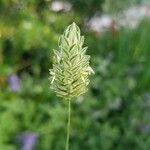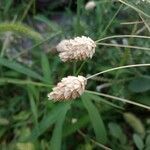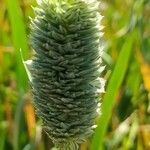Annual, caespitose. Culms 30–120 cm high, 5 or 6-noded. Young shoots extravaginal. Leaves: ligule entire; blade 5–30 (–42) cm long, mostly 3–12 mm wide. Panicles spike-like or capitate, 1.5–6 (–7) cm long, ovoid (to cylindrical), uninterrupted. Spikelets all bisexual. Glumes equal, mostly 6–9 mm long, scaberulous (often mainly on nerves and wing), sparsely hairy, with conspicuous keel-wing broad and prominent on upper half of keel and tapering more gradually to base than to apex, 3 (–5)-nerved. Sterile lemmas 2, subequal, usually (2–) 2.5–3.5 (–4) mm long. Bisexual floret pale golden-brown at maturity; lemma 4.5–5.6 (–6) mm long, acute, coriaceous, ±silky-hairy but sometimes glabrous near base; palea with similar hairs to lemma on keel; anthers 3–4 mm long, styles basally fused.
Tufted annual, 0.3-1.0 m high; culms usually fascicled, erect or geniculately ascending. Leaf blade 100-260 x 3-12 mm; ligule an unfringed membrane. Inflorescence an ovate to oblong-ovate panicle, 15-40 x 10-15 mm. Spikelets 7-10 mm long, laterally compressed; glumes ± equal, much longer than spikelet, pale green with dark green longitudinal stripes, sparsely hairy, prominently winged, wing broadening upwards. Florets 3; lowest 2 florets reduced, sterile, ± equal, 2.5-4.5 mm long, > 1/2 length of fertile lemma, broad, somewhat chaffy; uppermost floret bisexual, 4.8-6.8 x 1.0 mm, hard, pilose; anther 2.5-3.5 mm long. Flowering time Oct.-Dec.
Annual, loosely tufted. Culms 30–60(–100) cm tall. Uppermost leaf sheaths inflated with short blade; leaf blades 3–10 mm wide; ligule 3–5 mm. Panicle spikelike, very dense, ovate to oblong-ovate in outline, 1.5–4 cm. Spikelets obovate, strongly flattened, 7–10 mm; glumes oblanceolate, glabrous or puberulent, whitish with green veins, keel broadly winged above middle, wing margin entire, apex acute; sterile lemmas 2, equal, narrowly elliptic, chaffy, 2.5–4 mm, appressed-pilose; fertile lemma lanceolate, 5–6 mm, densely appressed-pubescent, shiny. Anthers 3–4 mm. Fl. and fr. Oct.
Tufted annual 300-1000 mm high; culms usually fascicled, erect or geniculately ascending. Leaf blade 100-260 x 3-12 mm. Inflorescence 15-40 x 10-15 mm, ovate to oblong-ovate. Spikelet 7-10 mm long; glumes pale green with dark green longitudinal stripes, sparsely hairy, prominently winged, wing entire, broadening upwards; sterile florets two, ± equal, 2.5-4.5 mm long, more than 1/2 the fertile lemma length, broad and somewhat chaffy; fertile floret 4.8-6.8 x 1.0 mm, pilose; anther 2.5-3.5 mm long.
Erect annual 3–10 dm; main cauline lvs mostly 4–10 mm wide; ligules 4–8 mm; infl 1.5–4 cm, dense, ellipsoid; glumes 7–10 mm, strongly winged along the keel distally, the midvein marked by a broad green stripe; sterile lemmas 2.5–4.5 mm, at least 1.5 mm wide, rather sparsely and finely hairy or subglabrous; fertile lemma 5–7 mm, densely and finely appressed-hairy; 2n=12. Native of Europe, intr. throughout most of N. Amer., but seldom abundant. Used commercially for canary-seed.
An annual grass. It grows 20-100 cm tall. It forms clumps. The stems are erect but there can be a bend near the base. The leaves are green and 15 cm long. The flower panicles are dense. They are 1.5-4 cm long. The spikelets are 6-10 mm long and 2.5-3 mm wide. The glumes are equal and have an abrupt point. The seeds are straw coloured. They are 4 mm long.
Annual; up to 0.6 m high; tufted. Culms usually fascicled; erect or geniculately ascending. Leaf blades 100-260 x 3-12 mm. Flowers: panicle compact; spike-like; 15-40 x 10-15 mm; spikelets 7-8 mm long; glumes prominently winged; wing broadening upwards; female-fertile floret pilose; sterile florets 2; ± equal; 2.5-4.5 mm long; broad and somewhat chaffy.
Annual, tufted (culms usually fascicled, erect or geniculately ascending), up to 0.6 m high. Leaf blades 100-260 mm long, 3-12 mm wide. Spikelets 7-8 mm long. Panicle 15-40 mm long, 10-15 mm wide; glumes prominently winged, wing broadening upwards; female-fertile floret pilose; sterile florets 2, ± equal, 2.5-4.5 mm long, broad and somewhat chaffy.
Annual to 60 cm. Leaves linear-lanceolate. Spikelets 7-8 mm long, in a cylindrical spike-like panicle 2-4 cm long, glumes prominently winged, sterile florets 2, ± equal.
